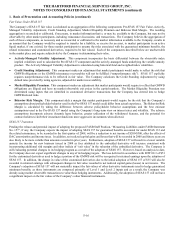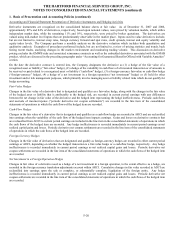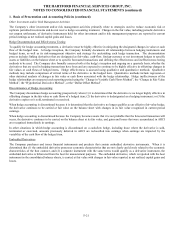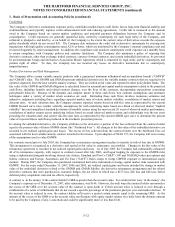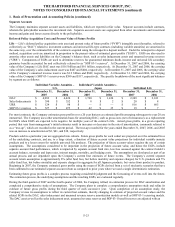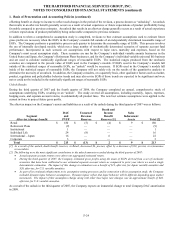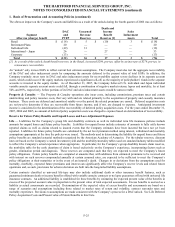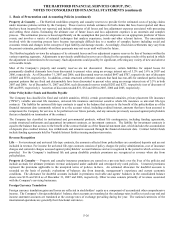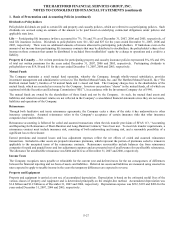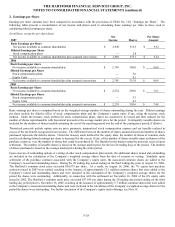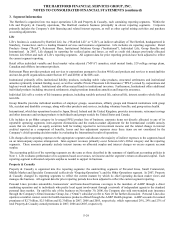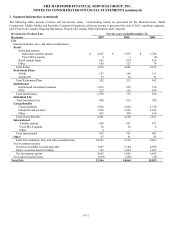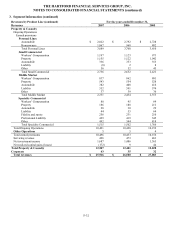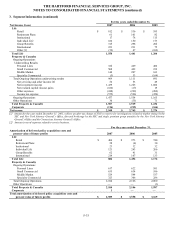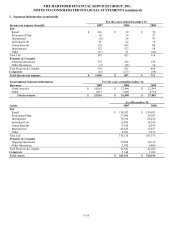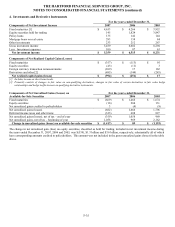The Hartford 2007 Annual Report Download - page 203
Download and view the complete annual report
Please find page 203 of the 2007 The Hartford annual report below. You can navigate through the pages in the report by either clicking on the pages listed below, or by using the keyword search tool below to find specific information within the annual report.THE HARTFORD FINANCIAL SERVICES GROUP, INC.
NOTES TO CONSOLIDATED FINANCIAL STATEMENTS (continued)
F-26
1. Basis of Presentation and Accounting Policies (continued)
Property & Casualty — The Hartford establishes property and casualty reserves to provide for the estimated costs of paying claims
under insurance policies written by the Company. These reserves include estimates for both claims that have been reported and those
that have been incurred but not reported, and include estimates of all losses and loss adjustment expenses associated with processing
and settling these claims. Estimating the ultimate cost of future losses and loss adjustment expenses is an uncertain and complex
process. This estimation process is based significantly on the assumption that past developments are an appropriate predictor of future
events, and involves a variety of actuarial techniques that analyze experience, trends and other relevant factors. The uncertainties
involved with the reserving process have become increasingly difficult due to a number of complex factors including social and
economic trends and changes in the concepts of legal liability and damage awards. Accordingly, final claim settlements may vary from
the present estimates, particularly when those payments may not occur until well into the future.
The Hartford regularly reviews the adequacy of its estimated losses and loss adjustment expense reserves by line of business within the
various reporting segments. Adjustments to previously established reserves are reflected in the operating results of the period in which
the adjustment is determined to be necessary. Such adjustments could possibly be significant, reflecting any variety of new and adverse
or favorable trends.
Most of the Company’ s property and casualty reserves are not discounted. However, certain liabilities for unpaid losses for
permanently disabled claimants have been discounted to present value using an average interest rate of 5.5% and 5.6% in 2007 and
2006, respectively. As of December 31, 2007 and 2006, such discounted reserves totaled $647 and $707, respectively (net of discounts
of $483 and $510, respectively). In addition, certain structured settlement contracts that fund loss run-offs for unrelated parties having
payment patterns that are fixed and determinable have been discounted to present value using an average interest rate of 5.5% in both
2007 and 2006. As of December 31, 2007 and 2006, such discounted reserves totaled $282 and $273, respectively (net of discounts of
$85 and $95, respectively). Accretion of discounts totaled $31, $32 and $30 in 2007, 2006 and 2005, respectively.
Other Policyholder Funds and Benefits Payable
The Company has classified its fixed and variable annuities, 401(k), certain governmental annuities, private placement life insurance
(“PPLI”), variable universal life insurance, universal life insurance and interest sensitive whole life insurance as universal life-type
contracts. The liability for universal life-type contracts is equal to the balance that accrues to the benefit of the policyholders as of the
financial statement date (commonly referred to as the account value), including credited interest, amounts that have been assessed to
compensate the Company for services to be performed over future periods, and any amounts previously assessed against policyholders
that are refundable on termination of the contract.
The Company has classified its institutional and governmental products, without life contingencies, including funding agreements,
certain structured settlements and guaranteed investment contracts, as investment contracts. The liability for investment contracts is
equal to the balance that accrues to the benefit of the contract holder as of the financial statement date, which includes the accumulation
of deposits plus credited interest, less withdrawals and amounts assessed through the financial statement date. Contract holder funds
include funding agreements held by Variable Interest Entities issuing medium-term notes.
Revenue Recognition
Life — For investment and universal life-type contracts, the amounts collected from policyholders are considered deposits and are not
included in revenue. Fee income for universal life-type contracts consists of policy charges for policy administration, cost of insurance
charges and surrender charges assessed against policyholders’ account balances and are recognized in the period in which services are
provided. For the Company’ s traditional life and group disability products premiums are recognized as revenue when due from
policyholders.
Property & Casualty — Property and casualty insurance premiums are earned on a pro rata basis over the lives of the policies and
include accruals for ultimate premium revenue anticipated under auditable and retrospectively rated policies. Unearned premiums
represent the premiums applicable to the unexpired terms of policies in-force. An estimated allowance for doubtful accounts is
recorded on the basis of periodic evaluations of balances due from insureds, management’ s experience and current economic
conditions. The allowance for doubtful accounts included in premiums receivable and agents’ balances in the consolidated balance
sheets was $126 and $114 as of December 31, 2007 and 2006, respectively. Other revenue consists primarily of revenues associated
with the Company’ s servicing businesses.
Foreign Currency Translation
Foreign currency translation gains and losses are reflected in stockholders’ equity as a component of accumulated other comprehensive
income. The Company’ s foreign subsidiaries’ balance sheet accounts are translated at the exchange rates in effect at each year end and
income statement accounts are translated at the average rates of exchange prevailing during the year. The national currencies of the
international operations are generally their functional currencies.


